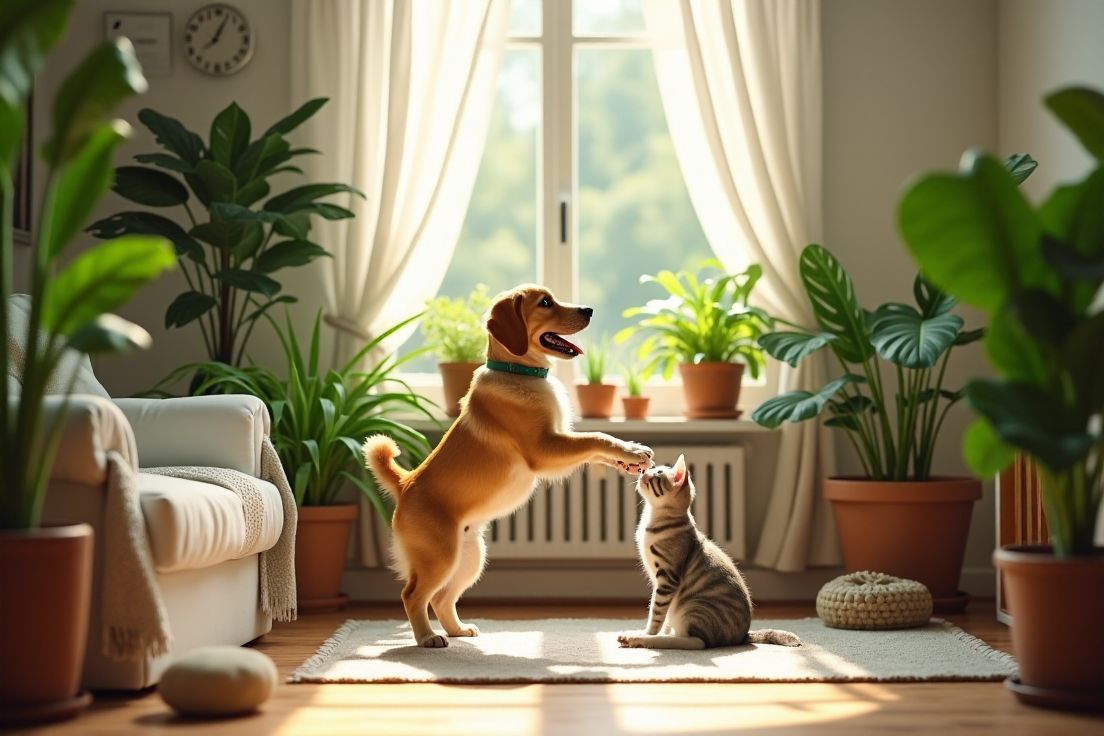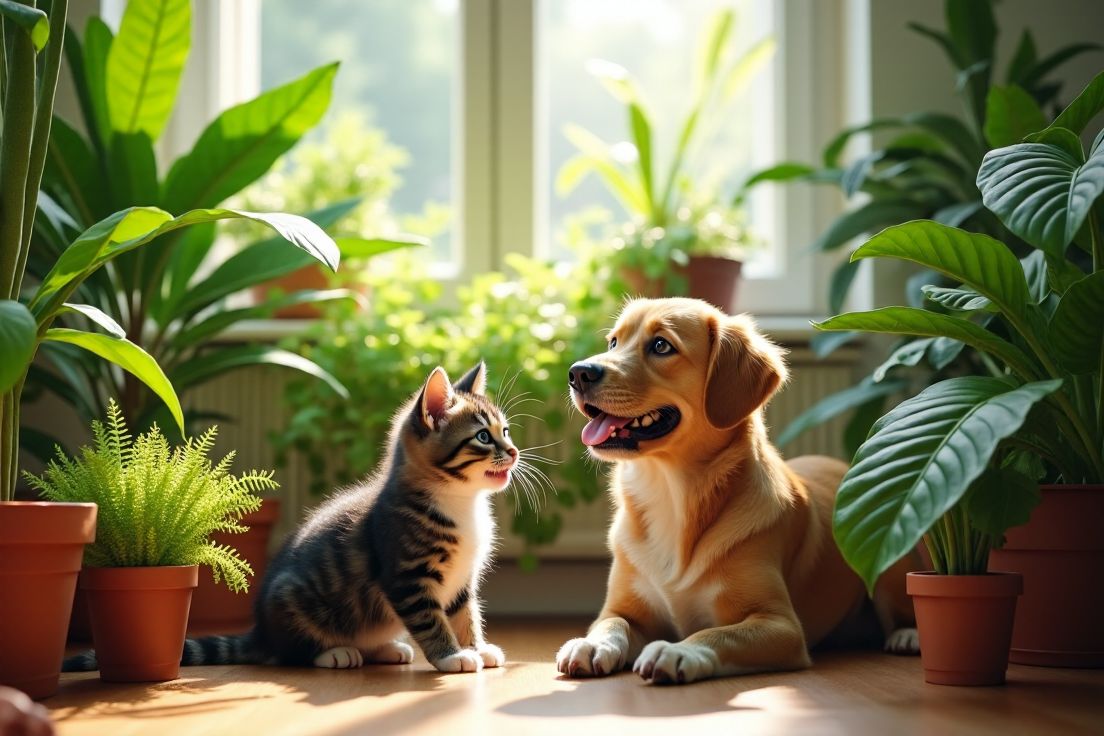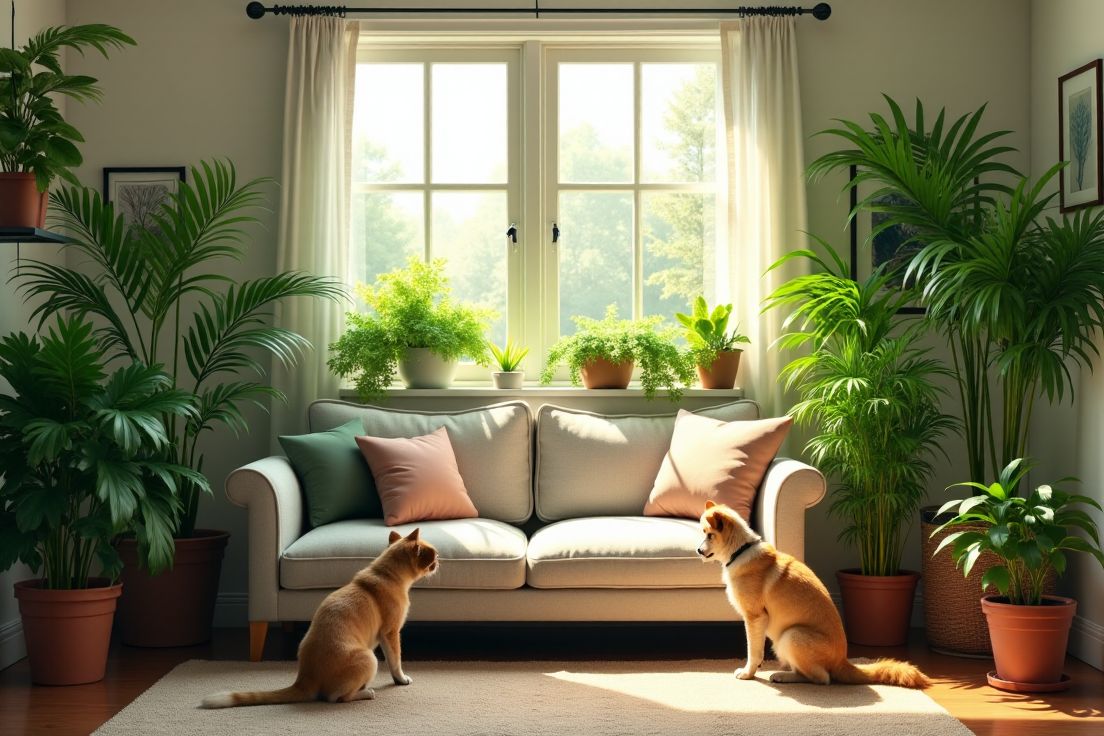When you have pets at home, it is important to choose plants that are safe for them. Some plants can be harmful if your pets decide to chew on them, so knowing which ones are safe is essential. This guide will help you understand which plant varieties you can enjoy without putting your furry friends at risk.
There are many pet-friendly plants that can brighten up your home and garden. For example, spider plants and Boston ferns are both beautiful and safe for pets. By selecting the right plants, you can create a lush, inviting space that keeps your pets out of harm’s way.
Choosing Safe Plants for Your Pets

When selecting plants for a home with pets, it’s essential to know which varieties are genuinely safe. Certain plants may seem harmless but can pose risks through toxic properties. Familiarizing yourself with pet-friendly options allows you to enjoy indoor and outdoor greenery without worrying about your furry friends.
Some popular pet-safe plants include spider plants, Boston ferns, and petunias.
Choosing the right plants for a home with pets is important for their safety. The following table lists some pet-friendly plants along with their characteristics.
| Plant Name | Type | Light Requirements | Watering Needs |
|---|---|---|---|
| Spider Plant | Houseplant | Bright, indirect light | Moderate, allow top inch of soil to dry |
| Boston Fern | Houseplant | Partial shade | Keep soil evenly moist |
| Petunia | Annual Flower | Full sun | Regular watering, especially in containers |
| Areca Palm | Houseplant | Bright, indirect light | Keep soil slightly moist |
| Bamboo Palm | Houseplant | Indirect light | Water when the top inch of soil is dry |
| Calathea | Houseplant | Low to bright indirect light | Keep soil slightly moist |
These plants not only enhance your living space but also provide safe environments for curious pets. It’s advisable to check labels or consult reliable resources to confirm a plant’s safety before bringing it into your home.
Additionally, consider the placement of plants. Keeping them out of reach from playful pets can further reduce any chance of accidental ingestion.
Use decorative shelves or hang plants in spots where they can’t be easily accessed.
Understanding the specific needs and behaviors of your pets can also help guide your choices. For example, while some dogs may be more prone to chewing on plants, others may show less interest. Tailoring your plant selection to your pets habits can ensure a harmonious environment.
By being proactive and informed, you can cultivate an inviting space that supports both your love for plants and a safe home for your pets.
Safe Indoor Plants for Pets
When looking for indoor plants that wont harm your pets, consider varieties that are both beautiful and safe. Besides the spider plant and Boston fern, there are plenty of other choices that can brighten up your home while keeping your furry companions safe. For instance, the areca palm is a great option; it thrives in bright, indirect light and needs slightly moist soil.
Another excellent choice is the bamboo palm, which flourishes in indirect light and can signal when it needs watering by allowing the top inch of soil to dry out.
If youre interested in colorful blooms, petunias can add a vibrant touch to your indoor garden. They require full sun and regular watering, making them ideal for sunny spots.
Calathea plants are also pet-friendly, offering stunning leaf patterns while growing well in low to bright indirect light. Keep their soil slightly moist for optimal health.
Safe Outdoor Plants for Pets
Creating a pet-friendly outdoor space starts with selecting the right plants. Many options can add beauty to your garden while ensuring the safety of your dogs and cats. For example, marigolds are vibrant flowers that brighten up any area. They are non-toxic to pets and can even help repel certain insects.
Another excellent choice is the rosemary herb. This fragrant plant can thrive in the sun and is safe for both dogs and cats. Not only does it add flavor to your dishes, but it also serves as a lovely decorative plant.
For those looking to incorporate greenery, the spider plant shines outdoors too.
Its arching leaves and ability to adapt to various light conditions make it a great addition to patios or gardens, all while being non-toxic for pets.
Additionally, you might consider planting lavender. This popular herb not only smells wonderful but also blooms beautifully and is safe for animals. It can attract beneficial pollinators to your garden as well.
Pet-Friendly Houseplants for Your Home
For pet owners seeking houseplants that won’t harm their animals, several attractive options abound. The spider plant, known for its striking green and white striped leaves, is an excellent choice. It grows well in bright, indirect light and is also easy to care for, making it a favorite among many indoor gardeners.
The areca palm stands out with its graceful fronds.
This plant enjoys bright, indirect light and prefers slightly moist soil, adding a touch of tropical flair to your space without risking your pet’s health.
Another great option is the Calathea, which features beautiful, patterned leaves. It flourishes in low to bright indirect light and thrives with slightly moist soil. This colorful plant not only looks great but also is completely safe for your pets.
Add a vibrant touch to your home with these pet-friendly plants. Both options thrive in various light conditions and are easy to care for, making them perfect for any plant lover.
- Both plants are non-toxic to pets, providing peace of mind for pet owners.
- They help to purify the air, enhancing the overall quality of your indoor environment.
- Regular misting can be beneficial for these plants, promoting humidity and leaf health.
- They can be easily propagated, allowing you to grow new plants from cuttings.
- These plants add a lush, tropical aesthetic to any room, elevating your decor style.
Add some color to your home with flowering plants like petunias. These annuals brighten up any room and thrive in full sun, needing regular watering to keep them lively. Their vibrant blooms can be a delightful addition to your indoor garden.
Last but not least, the Boston fern is a classic choice for any pet-friendly home.
Choosing Safe Plants for Your Furry Friends

Choosing plants that are safe for your pets involves understanding common varieties that pose no harm. Many popular houseplants and outdoor plants can add beauty to your home without risking your furry friends’ well-being. For instance, the spider plant is not only easy to care for but also features striking green and white leaves, making it a great addition to any room.
When selecting options for your garden, consider marigolds.
These lively flowers not only brighten the landscape but also encourage pollinators while being safe for pets. Additionally, herbs like rosemary can be a lovely touch in your garden. They not only enhance your meals but also provide an aromatic experience without being harmful to your animals.
Its wise to consult lists or guides that cover pet-safe species, as many commonly found plants have non-toxic alternatives.
Safe Indoor Plants for Pet Owners
For pet owners seeking the best indoor plants, several options are both attractive and safe. The spider plant is known for its resilience and unique arching leaves. Its easy to care for and grows well in various lighting conditions, making it a top choice for homes with pets.
Another appealing choice is the areca palm.
Its feathery fronds can add a tropical vibe to your home without posing any risk to your furry friends. This plant prefers bright, indirect light and needs its soil to stay slightly moist to thrive.
If you’re looking for something with a burst of color, consider petunias. These flowers bloom beautifully and bring a lively touch to any indoor setting.
They require full sun to flourish and should be watered regularly, which makes them ideal for sunny windows.
Calathea plants offer stunning leaf designs and are safe for pets too. They thrive under low to bright indirect light, and their soil should be kept slightly moist, making them suitable for various environments.
By choosing these plants, you can create a beautiful indoor garden that is safe for your curious companions.
The combination of aesthetics and safety helps ensure a happy home for both you and your pets.
Common Outdoor Plants That Are Non-Toxic to Pets
When it comes to creating a safe outdoor environment for pets, there are numerous plants that add charm while remaining non-toxic. One popular choice is the marigold. These bright flowers not only enhance garden aesthetics but can also deter unwanted insects.
Another great garden plant is rosemary.
This aromatic herb thrives in sunny spots and is completely safe for dogs and cats. It offers culinary benefits as well, making it a versatile addition to your outdoor space.
For a touch of greenery, consider planting basil. This herb is safe for pets and has a lovely fragrance.
It does well in both pots and garden beds, requiring plenty of sunlight and regular watering.
Lavender is another favorite, known for its delightful scent and beautiful purple flowers. It’s safe for pets and can attract beneficial pollinators while adding a soft touch to your landscape.
If you’re looking for something leafy, the spider plant can also thrive outdoors.
With its long, arching leaves, it adapts easily to various light conditions and remains non-toxic to pets.
Furthermore, a popular ground cover option is creeping thyme. Its not only safe for pets, but it also releases a pleasant aromatic scent, especially when walked upon. This makes it a charming and practical choice for garden pathways.
Benefits of Introducing Pet-Safe Plants at Home
Adding pet-safe plants to your home offers several advantages. First and foremost, it ensures your pets’ safety. Curious cats and dogs often explore their surroundings, and having non-toxic plants reduces the risk of accidental poisoning.
Moreover, these plants can enhance the atmosphere of your home.
They provide a vibrant touch of nature, making spaces feel more inviting and pleasant. You can enjoy the calming effects of greenery without worrying about potential dangers to your pets.
Pet-friendly plants can also improve air quality. Many houseplants are known for their ability to purify the air, making your environment healthier for both you and your furry companions.
Cleaner air can lead to better overall well-being for you and your pets.
Additionally, caring for plants can be a rewarding hobby. It allows you to connect with nature, relieve stress, and add a personal touch to your decor. With pet-safe options, you can embrace this hobby without compromising on the safety of your animals.
Understanding Pet-Safe Plant Varieties

Understanding which plants are safe for your pets involves knowing about their characteristics and care needs. Some plants, like the spider plant, are known for their easy-going nature and can thrive in different light conditions. They do not pose any health risks to pets, making them a popular choice for animal lovers.
The areca palm is another excellent option.
It boasts beautiful fronds and prefers bright, indirect light. Its water requirements are minimal, as it needs its soil to be slightly moist. This plant not only adds greenery but also acts as a safe environment for pets.
Calathea plants offer both stunning visuals and safety for animals.
They thrive in low to bright indirect light and should have their soil kept only slightly moist. This makes them perfect for various home settings while ensuring that pets are not at risk.
Some flowering options, such as petunias, can add vibrant colors to your home. They require full sunlight and regular watering, contributing to an inviting atmosphere without endangering pets.
Selecting Safe Greenery for Your Furry Friends
Choosing plants that are non-toxic for pets is a crucial decision for any pet owner. These plants help create a safe and inviting environment for your furry companions. Animals are naturally curious and may explore their surroundings by nibbling on leaves or digging in soil. Selecting safe greenery reduces the risks of harmful ingestion and potential health issues, allowing your pets to roam freely without concern.
Moreover, pet-friendly plants contribute positively to your homes atmosphere. They add beauty and life to your space while ensuring your pets are protected. Incorporating these plants makes it easier to maintain a harmonious living area, where you can enjoy nature alongside your beloved animals. Understanding which plants are safe keeps both your home and your pets happy.
Additionally, many non-toxic plants improve indoor air quality. As they grow, they can filter harmful toxins and release oxygen, creating a healthier environment for all inhabitants. This dual benefit highlights why its important to choose plants mindfully.
Finally, the joy of caring for plants shouldn’t come with the worry of potential harm to pets.
Pet-Friendly Indoor Plants for Your Furry Companions
In your quest for indoor plants that are safe for both cats and dogs, consider these options. The rubber plant, with its glossy leaves, is a stunning addition to any home and poses no risk to your pets. It prefers bright, indirect light and requires infrequent watering, making it relatively easy to care for.
Another wonderful choice is the friendship plant.
This plant features unique, round leaves and thrives in low light conditions. It enjoys regular watering, ensuring that its soil stays slightly moist. Plus, it’s a non-toxic option for pets, giving you peace of mind.
The African violet is a beautiful flowering plant that fits well in pet-friendly homes.
It takes pride in its lovely blooms and prefers bright, indirect light. Keep the soil moist but not soggy to help this plant flourish.
Lastly, the parlor palm stands out among indoor options. This palm adds a tropical feel to your space and is completely safe for pets.
Best Outdoor Plants for Pet-Friendly Gardens
When designing a garden that’s safe for pets, there are multiple outdoor plants that can enhance the beauty of your space while ensuring a safe environment. A wonderful choice is the marigold, known for its bright colors and ability to deter pests, and it’s non-toxic to pets. Another excellent option is rosemary; this herb not only adds flavor to your meals but also thrives in sunny locations without posing any harm to your furry friends.
Consider incorporating basil into your garden as well.
This fragrant herb is completely safe and can flourish in both pots and garden beds. Likewise, lavender offers a beautiful floral addition while being safe for pets, and it attracts helpful pollinators, making your garden even more lively.
For a lush look, the spider plant is a great option outdoors. Its long, arching leaves make it visually appealing, and it adapts well to different light conditions while remaining non-toxic for pets.
Creeping thyme also makes for an excellent ground cover. It’s safe for pets, and its aromatic leaves release a pleasant scent when stepped on, adding an enjoyable sensory element to your garden.
You might also want to consider bluebell flowers. They produce lovely blue blooms and are safe for pets, providing a charming splash of color to your garden beds.
Planting these selections will create a vibrant and captivating outdoor space that is completely safe for your pets to explore.
Frequently Asked Questions
Below are some frequently asked questions regarding safe plants for homes with pets. This section aims to provide clear and concise information for pet owners looking to create a safe and inviting environment with plants.
What are some examples of pet-safe indoor plants?
Pet-safe indoor plants include spider plants, Boston ferns, areca palms, bamboo palms, calathea, and petunias. These plants are non-toxic and safe for both cats and dogs.
How can I make sure the plants I choose are safe for my pets?
Always check plant labels and do thorough research on varieties before purchasing. Consulting reliable resources or guides that specifically list pet-safe plants is advisable to ensure their safety.
What are the light requirements for pet-friendly plants?
Pet-friendly plants have varying light requirements. For example, spider plants prefer bright, indirect light, while Boston ferns thrive in partial shade. Ensure to match plants to the lighting conditions of your space.
Can pet-safe plants also improve indoor air quality?
Yes, many pet-safe plants can help purify the air by filtering harmful toxins and releasing oxygen. This improves the overall air quality within your home, benefiting both you and your pets.
Should I place plants out of reach of my pets?
Yes, it’s ideal to keep plants out of reach from playful pets to minimize the chance of accidental ingestion. Using decorative shelves or hanging plants can be effective solutions.
Are there specific outdoor plants that are safe for pets?
Safe outdoor plants for pets include marigolds, rosemary, lavender, basil, and spider plants. These plants add beauty to your garden while ensuring the safety of your furry companions.
What are the benefits of introducing pet-safe plants at home?
Introducing pet-safe plants offers several benefits including enhancing your home’s aesthetic, ensuring your pets’ safety, improving air quality, and providing a rewarding hobby for plant care.
Conclusion
Choosing plants that are safe for your pets not only protects their health but also enhances your home. By selecting pet-friendly varieties, you create a beautiful and inviting space where your furry friends can explore without worry.
Remember to research the plants before bringing them home. Knowing which ones are safe and understanding their care needs will help you create a harmonious environment for both you and your pets.